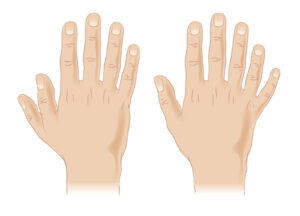Polydactyly
If you suffer from Polydactyly, please Schedule an appointment with one of our orthopedic specialists as soon as possible.

What is Polydactyly?
Polydactyly (also known as hexadactyly or hyperdactyly) refers to a medical condition in which a limb has one or more extra digits (fingers/toes) present. Poly means many while dactylos means digits (Umair et al., 2018). The extra digit can appear on either side of the extremity, or at the center. Polydactyly has links with more than 100 genetic syndromes but most cases come in isolation. The extra digits in the feet or hands may or may not contain bone and may present unilaterally or bilaterally (Rac, McKinney and Gandhi, 2019).
How is Polydactyly Classified?
The most widely used system of classification groups polydactyly into three forms, Preaxial Polydactyly (PPD), Postaxial Polydactyly (PAP), and complex types. PPD and PAP remain the most common. PPD describes the situation where the extra digit grows toward the first digit of the foot (medially) or the first digit of the hand (thumb; radial side). In PAP, one or more additional ulnar or fibular digits attach along the fifth finger. This remains 75% more common than PPD. Complex types look different from that of PAP and PPD. This includes Mirror-Image Polydactyly (MIP), Central or Mesoaxial polydactyly, Palmar or Dorsal Polydactyly, and Haas Type Polysyndactyly (Umair et al., 2018).
How Do Orthopedic Hand and Wrist Specialists Diagnose Polydactyly?
Physicians usually diagnose this condition on an infant in the womb. Transvaginal sonography helps visualize fetal finger buds after the fetus has reached 9 weeks of intrauterine life (Amin and Carter, 2021). Ultrasound can help identify the presence of an extra digit on the foot or on the hand. Imaging in the axial and coronal plane helps in confirming polydactyly. Ultrasound imaging in 3-D has an advantage over 2-D due to the fact that 3-D sonography allows for an easier detection of the extra digit which may or may not contain bone. A 3-D ultrasound enables a more detailed assessment of the condition (Rac, McKinney and Gandhi, 2019).
Other Diagnosis
Other common syndromes that resemble this condition include trisomy 13, Meckel-Gruber syndrome, Diabetic embryopathy, Smith-Lemli-Opitz syndrome, Carpenter syndrome, Pallister-Hall syndrome, and Greig cephalopolysyndactyly syndrome. Differential diagnoses may include both syndromic and nonsyndromic causes (Rac, McKinney and Gandhi, 2019).
Genetic factors of Polydactyly
Determining whether a diagnosed case of this condition came isolated or with a genetic syndrome helps a lot. Most isolated cases of polydactyly come from inheriting the condition from parents. Upon suspicion of a genetic polydactyly case, diagnostic testing comes in (Rac, McKinney and Gandhi, 2019).
Pregnancy and Delivery Management
As indicated above, ultrasound examination helps in assessing the situation. Ultrasound also helps upon confirmation of diagnosis. The presence of other anomalies or the suspicion of a syndromic cause call for further imaging, such as a fetal echocardiogram. Depending on the sonography reports, patients may receive a referral for plastic surgery or pediatric orthopedics. Delivery at a tertiary care center may help in case of the presence of other anomalies (Rac, McKinney and Gandhi, 2019). Some cases require the use of surgery.
Treatment
The complexity of the nature and type of deformity determines the course of treatment. Surgical therapy helps improve the quality of life. (Amin and Carter, 2021).
If you would like to speak to a Texas based Orthopedic Specialist in the DFW Area, give us a call at 817-697-4038, or contact us over the web. Tele-medicine appointments are also available
References
Amin, A. and Carter, K.R. (2021). Polydactyly. [online] Nih.gov. Available at: https://www.ncbi.nlm.nih.gov/books/NBK562295/#:~:text=Polydactyly%2C%20also%20known%20as%20hyperdactyly,posterior%20patterning%20of%20developing%20limb. [Accessed 22 Feb. 2022].
Rac, M.W.F., McKinney, J. and Gandhi, M. (2019). Polydactyly. American Journal of Obstetrics and Gynecology, [online] 221(6), pp.B13–B15. Available at: https://pubmed.ncbi.nlm.nih.gov/31787158/ [Accessed 22 Feb. 2022].
Umair, M., Ahmad, F., Bilal, M., Ahmad, W. and Alfadhel, M. (2018). Clinical Genetics of Polydactyly: An Updated Review. Frontiers in Genetics, [online] 9. Available at: https://pubmed.ncbi.nlm.nih.gov/30459804/ [Accessed 22 Feb. 2022].

